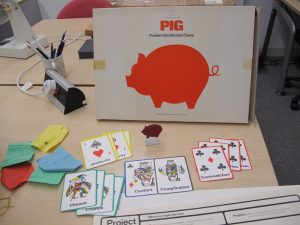PIG – the Problem Identification Game – from the OU Archive
PIG was part of the module T262 (1975-1982) entitled Man-made futures: design and technology, a 30 credit module students typically enrolled on after completing their Level 1 study, which then was two foundation modules (60 credits each) such as The man-made world: a foundation course and Humanities: a foundation course or Mathematics: a foundation course. As the OU starts to turn 50, I thought I would have a look back at this Design Artifact from our archive when the OU was a mere 5 years old…
![]()
PIG, as it’s acronym suggests, is a game which is to be played by students during their studies – preferably over a 1-2 week period. It was devised by Robin Jaques and Reg Talbot and based on the seminal design textbook by John Chris Jones entitled Design Methods (1970, then published again in 1980 and 1992). Jones’ work also informed the Design Innovation Groups’ Meta-Cards which were used in the module T100.
PIG was indeed a bit of pig according to student feedback and some members of the design team that I recently spoke with; the instructions give you some idea of how precise and difficult it was to utilise. In order to play you should have previously read 6 units of material on Food, Shelter and Work in the Future Access Files. Then get ready to ‘prep’ for the game by recording any problem you encounter in your readings – these were to be written down in formal problem statement language. Then the game has 3 parts – Exploration, Formulation and Project Potential. Suggestions included that you need at least 3 hours to get something useful out of it, and in some cases students probably spent many more hours than that as the final outcome fed into their design project which was assessed.
Here is what the gamebox and the main components looked like (see next image).

In the Exploration phase students were asked to look at the problem from different points of view and continue to explore the context of the problem. At the end of the phase the students should have either shifted their interest to a different problem or have a clarification of ‘what the problem really is’. To carry out this you would need to ‘go around’ the board a few times collecting various cards along the way which would interact with your problem statement. The game board has 25 steps to go through, and of course, you could always go around again!
The cards are entitled Conflict, Similarity, Chance, Contradiction and Complication and resemble playing cards, but contain copious text on the reverse side. Note the way that contradiction card (in the far right of the photo) for example uses the mixture of a diamond and clubs in order to symbolise the mixed suits – subtle yet humorous.
In this case the similarity card reveals the Association device – and then asks you to choose an element word from your problem statement – say this to your game partner and ask them to say the first thing that comes into their mind. From this new word, reformulate your problem statement or generate new ideas. With 24 cards over five broad areas, you can see that this goes on for some time across the 25 spaces. The manual notes that “Playing PIG is similar to many other activities in that what you get out of it is very much a function of what you put into it., and …You should feel mentally tired after a session.” I can only agree with this sentiment even though I must admit I haven’t tried to play PIG applied to an actual issue.
The came the Formulation phase, the Expansion Net and after all this divergence the students then had to begin to converge in Phase 3 – the Project Potential – using the Project Matrix.
The matrix contained a vertical axis of how you might intervene mapped against where might you intervene (horizontally, in the core or periphery) onto 3 key ‘how’ areas – Action, Plan and Research – to create a 6 compartment framework for considering the final problem statement and potential design solutions you derived from the various rounds of the game. Students had to really work towards a single final outcome as they were asked to provide some evidence in their formulation worksheets that they had actually been playing.
Given the amount of student time and effort required for PIG I am surprised that it was a single assignment in terms of assessment and have heard stories that some students ‘invented’ their way around the game rather than actually putting in so much – I’d call that assessment driven, or designing shortcuts.
Thank you to both Ruth Cammies in our Archive and Robin Roy for highlighting this artifact.

Leave a Reply